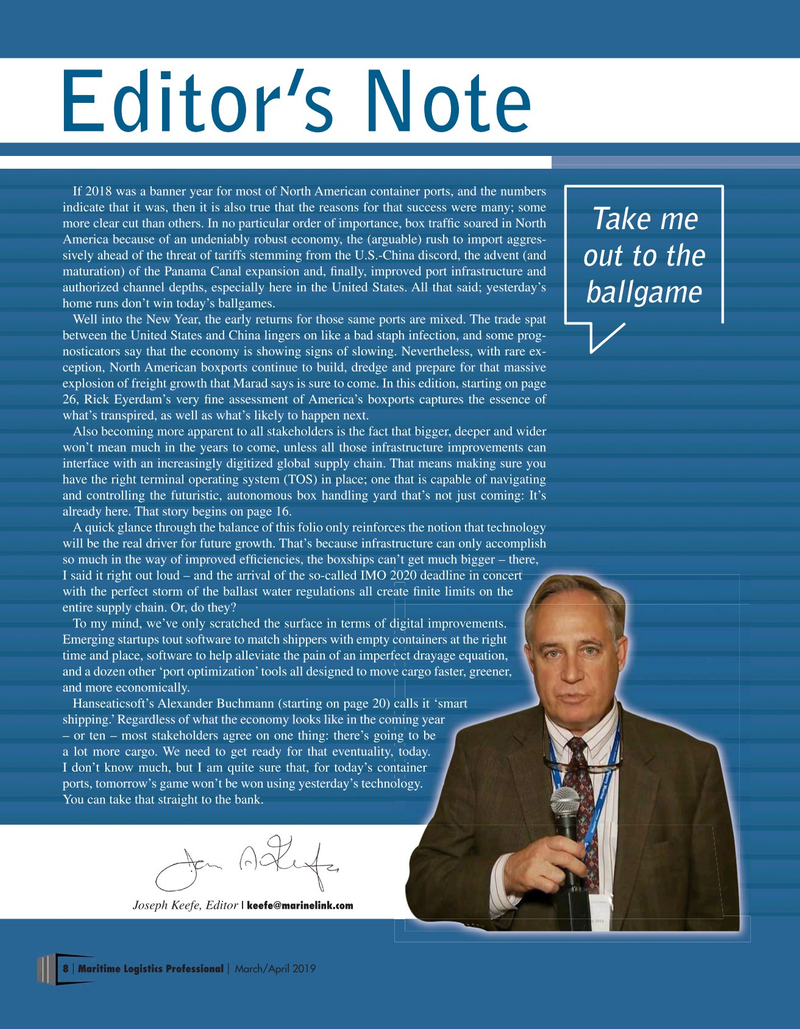
Page 8: of Maritime Logistics Professional Magazine (Mar/Apr 2019)
Container Ports
Read this page in Pdf, Flash or Html5 edition of Mar/Apr 2019 Maritime Logistics Professional Magazine
Editor’s Note
If 2018 was a banner year for most of North American container ports, and the numbers indicate that it was, then it is also true that the reasons for that success were many; some more clear cut than others. In no particular order of importance, box traf?c soared in North
Take me
America because of an undeniably robust economy, the (arguable) rush to import aggres- sively ahead of the threat of tariffs stemming from the U.S.-China discord, the advent (and out to the maturation) of the Panama Canal expansion and, ?nally, improved port infrastructure and authorized channel depths, especially here in the United States. All that said; yesterday’s ballgame home runs don’t win today’s ballgames.
Well into the New Year, the early returns for those same ports are mixed. The trade spat between the United States and China lingers on like a bad staph infection, and some prog- nosticators say that the economy is showing signs of slowing. Nevertheless, with rare ex- ception, North American boxports continue to build, dredge and prepare for that massive explosion of freight growth that Marad says is sure to come. In this edition, starting on page 26, Rick Eyerdam’s very ?ne assessment of America’s boxports captures the essence of what’s transpired, as well as what’s likely to happen next.
Also becoming more apparent to all stakeholders is the fact that bigger, deeper and wider won’t mean much in the years to come, unless all those infrastructure improvements can interface with an increasingly digitized global supply chain. That means making sure you have the right terminal operating system (TOS) in place; one that is capable of navigating and controlling the futuristic, autonomous box handling yard that’s not just coming: It’s already here. That story begins on page 16.
A quick glance through the balance of this folio only reinforces the notion that technology will be the real driver for future growth. That’s because infrastructure can only accomplish so much in the way of improved ef?ciencies, the boxships can’t get much bigger – there, ggg,
I said it right out loud – and the arrival of the so-called IMO 2020 deadline in concert 2020 deadline in concert 20 deadline in concert ate e ?nite limits on the with the perfect storm of the ballast water regulations all create ?nite limits on the entire supply chain. Or, do they?
To my mind, we’ve only scratched the surface in terms of digital improvements. dig gital improvements.
Emerging startups tout software to match shippers with empty containers at the right containers at the right time and place, software to help alleviate the pain of an imperfect drayage equation, fec ct drayage equation, and a dozen other ‘port optimization’ tools all designed to move cargo faster, greener, e c cargo faster, greener, and more economically.
Hanseaticsoft’s Alexander Buchmann (starting on page 20) calls it ‘smart ca alls it ‘smart shipping.’ Regardless of what the economy looks like in the coming year mi ing year – or ten – most stakeholders agree on one thing: there’s going to be ng to be a lot more cargo. We need to get ready for that eventuality, today. to oday.
I don’t know much, but I am quite sure that, for today’s container nta ainer ports, tomorrow’s game won’t be won using yesterday’s technology. olo ogy.
You can take that straight to the bank.
Joseph Keefe, Editor | [email protected] 8 Maritime Logistics Professional March/April 2019 | |

 7
7

 9
9
